neutral to beneficial; feeds on potentially harmful fungi
Ameroseius Berlese, 1904 (some authors cite the year as 1903; here we verified the original publication date)
Superorder Parasitiformes » Order Mesostigmata » Suborder Monogynaspida » Hyporder Dermanyssiae » Family Ameroseiidae » Genus Ameroseius
Seius echinatus C. L. Koch, 1839 (= Acarus corbicula Sowerby, 1806 = Seius muricatus Koch, 1839)
Kleemannia Oudemans is considered either as a junior synonym (Halliday, 1997Halliday, 1997:
Halliday, R. B. 1997. Revision of the Australian Ameroseiidae (Acarina: Mesostigmata). Invertebrate Taxonomy.11: 179-201.) or as a valid genus (Evans and Till, 1979Evans and Till, 1979:
Evans, G. O. amp; W. M. Till. 1979. Mesostigmatic mites of Britain and Ireland (Chelicerata: Acari-Parasitiformes). An introduction to their external morphology and classification. Transactions of the Zoological Society of London.35: 145-270.). Here we follow the most recent works by considering Kleemannia a junior synonym of Ameroseius. However, below we give diagnostic character states of Kleemannia to differentiate it from the typical Ameroseius.
Female: Dorsal shield rugose, strongly sculptured or ornamented with a series of interconnecting ridges (Fig. 1). Dorsal shield with usually 29, or rarely 30 pairs of setae; dorsal shield setae usually large, plumose or serrated (Fig. 1). Marginal dorsal shield setae not conspicuously longer than setae in center of shield (Fig. 1). Sternal shieldsternal shield:
A shield in the anterior intercoxal region of parasitiform mites that bears one or more pairs of sternal setae.
 with 2 pairs of setae (rarely 3) (Figs. 2, 3). CorniculiCorniculus:
with 2 pairs of setae (rarely 3) (Figs. 2, 3). CorniculiCorniculus:
Paired, horn-like process (sometimes toothed, bifurcate, trifurcate, spine-like, spatulate, or membranous) on the subcapitulum of parasitiform mites. These processes usually support the salivary styli. If toothed could be confused with a rutellum, a possibly homologous structure in Acariformes and Opilioacarida.
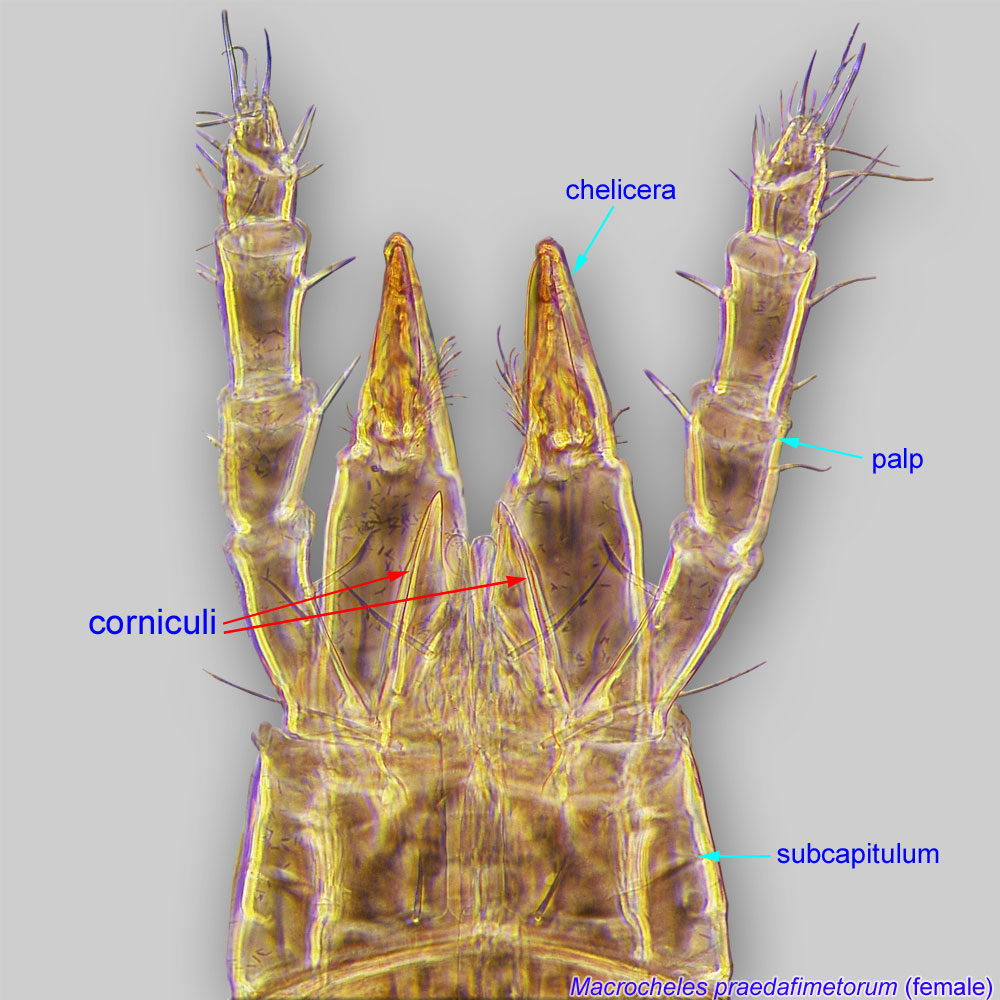 distally bifid or otherwise subdivided (Figs. 2, 7, 8). Legs I with ambulacrumambulacrum:
distally bifid or otherwise subdivided (Figs. 2, 7, 8). Legs I with ambulacrumambulacrum:
The claws and empodium of the apotele or pretarsus.
I (claws and pulvilluspulvillus:
a membranous, pad-like structure associated with the claws in Mesostigmata.
) present (Figs. 1, 2). Genugenu:
Leg or palp segment (also known as podomere or palpomere) between tibia and femur.
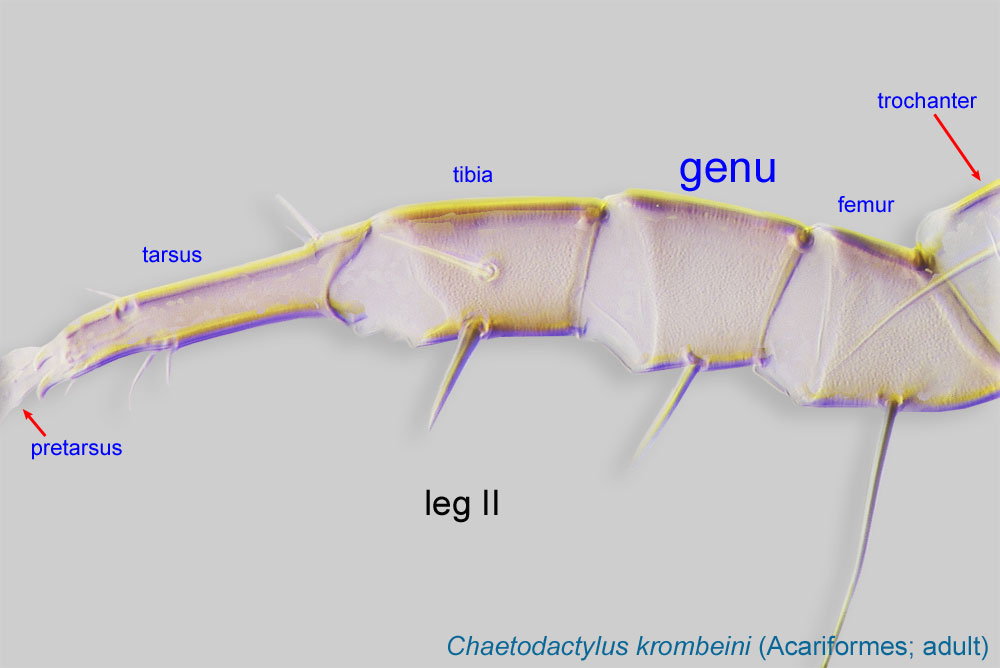 II with 1 or 2 (Kleemannia) ventral setae. Palppalp:
II with 1 or 2 (Kleemannia) ventral setae. Palppalp:
Second (after chelicera) paired appendage of the gnathosoma. Has a sensory function, but may be variously modified for other functions (e.g., raptorial, attachment to host, or filtering).
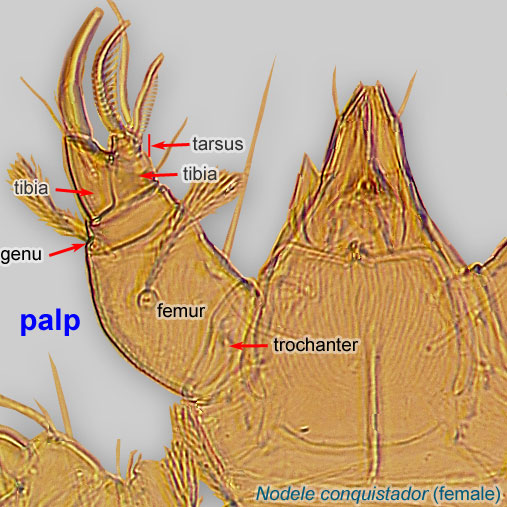 apoteleapotele:
apoteleapotele:
The most distal leg or palp segment.
3-tined or 2-tined (Kleemannia). With anal shieldanal shield:
In Mesostigmata, a ventral shield bearing the anal opening and circumanal setae (adanal or postanal setae), but without any ventral setae or pores (lyrifissures) on it. If ventral setae are present on shield than referred to as a ventrianal shield.
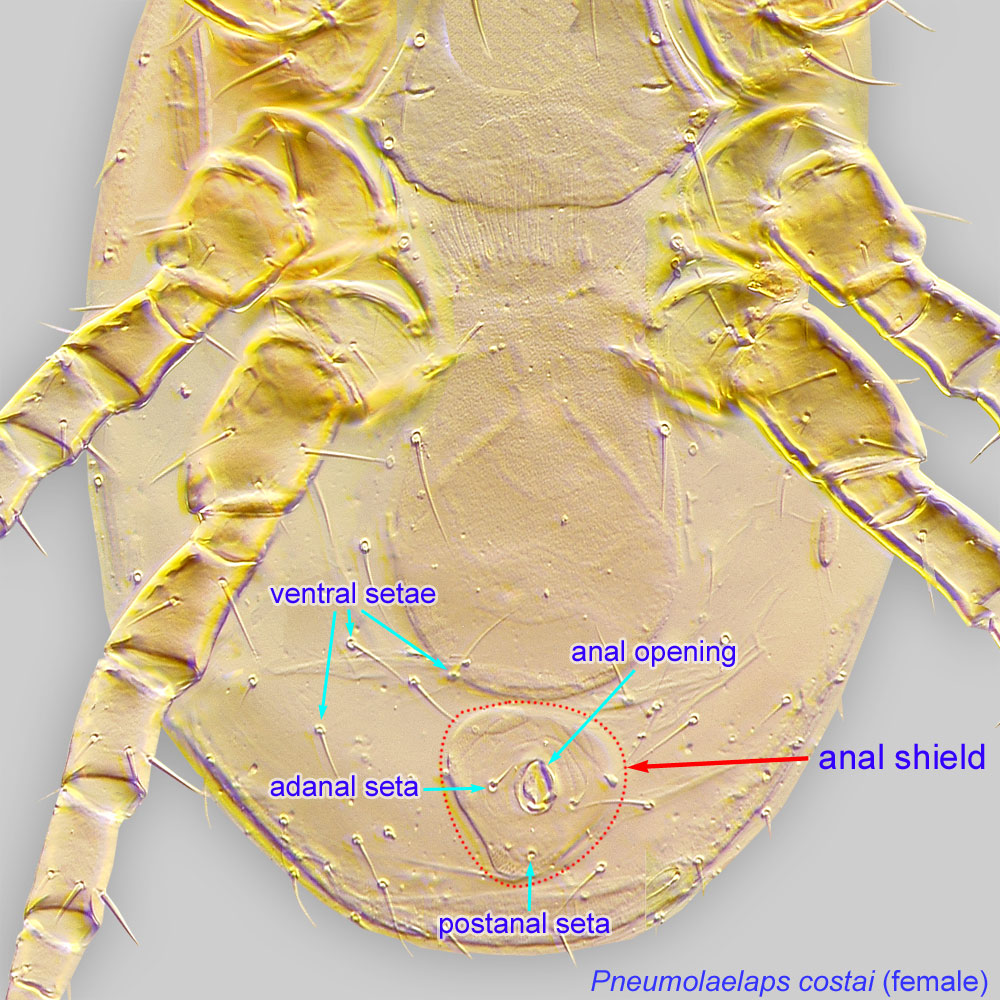 (similar to that of Ameroseiella) (Fig. 10) or ventrianal shieldventrianal shield:
(similar to that of Ameroseiella) (Fig. 10) or ventrianal shieldventrianal shield:
In Mesostigmata, a ventral shield bearing the anal opening, circumanal (postanal and adanal) setae, and one or more pairs of ventral setae or pores (lyrifissures) (see anal shield); may be narrow or very broad and covering most of the gaster.
 (Kleemannia) (Figs. 2, 4, 5, 6).
(Kleemannia) (Figs. 2, 4, 5, 6).
This is a species-rich genus. The two species found in hives of honey bees and nests of bumble bees in the Old World, Ameroseius plumigerus and A. plumosus, can be identified using keys from Karg, 1971Karg, 1971:
Karg, W. 1971. Acari (Acarina), Milben. Unterordnung Anactinochaeta (Parasitiformes). Die freilebenden Gamasina (Gamasides), Raubmilben. Die Tierwelt Deutschlands. 59. 475 pp. and Bregetova, 1977bBregetova, 1977b:
Bregetova, N. G. 1977b. [Family Ameroseiidae]. In [Opredelitel' obytayshchikh v pochve kleshchey Mesostigmata = Identification key to soil-inhabiting mites Mesostigmata], eds. M. S. Gilarov amp; N. G. Bregetova, 148-169. Leningrad: Nauka.. Two other species collected from large carpenter bees in Africa, Ameroseius bembix ealensis and Ameroseius benoiti, should be identified using the original description (Elsen, 1973Elsen, 1973:
Elsen, P. 1973. Nouvelles especes d' Ameroseius Barlese, 1903 (Acari, Mesostigmata: Ameroseiidae) phoretique d'hymenopteres et de coleopteres. Revue Zool Bot Afr.87: 729-757.). In addition, Sertitympanum aegyptiacus has been reported from bee hives (as Ameroseius aegyptiacus). This species has a single cog-wheel-like structure on the sternal shieldsternal shield:
A shield in the anterior intercoxal region of parasitiform mites that bears one or more pairs of sternal setae.
 , dorsal shield not rugose, short dorsal setae, and longitudinally elongated ventrianal shieldventrianal shield:
, dorsal shield not rugose, short dorsal setae, and longitudinally elongated ventrianal shieldventrianal shield:
In Mesostigmata, a ventral shield bearing the anal opening, circumanal (postanal and adanal) setae, and one or more pairs of ventral setae or pores (lyrifissures) (see anal shield); may be narrow or very broad and covering most of the gaster.
 . Based on these characteristics it probably does not belong to either Sertitympanum or Ameroseius.
. Based on these characteristics it probably does not belong to either Sertitympanum or Ameroseius.
Ameroseiella. Can be distinguished by the absence of the ambulacrumambulacrum:
The claws and empodium of the apotele or pretarsus.
on tarsitarsus:
Terminal segment (also known as podomere or palpomere) of legs or palps. In Parasitoformes it can be subdivided into telotarsus and basitarsus.
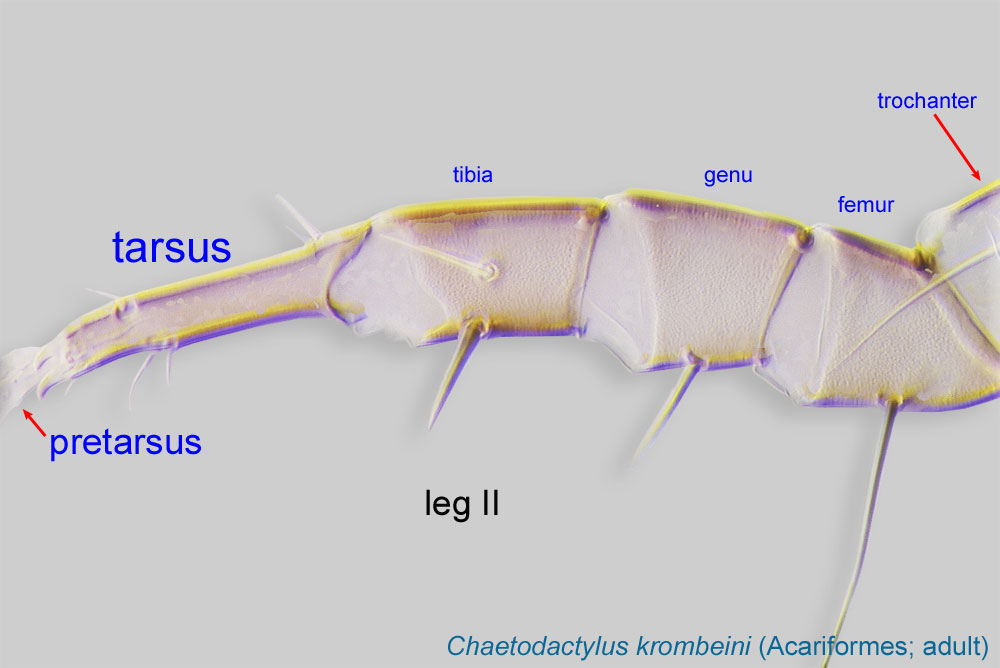 I (Figs. 9, 10) (present in Ameroseius, Figs. 1, 2).
I (Figs. 9, 10) (present in Ameroseius, Figs. 1, 2).
Sertitympanum. Can be distinguished by the presence of three cog-wheel-like structures on the sternal shieldsternal shield:
A shield in the anterior intercoxal region of parasitiform mites that bears one or more pairs of sternal setae.
 (none or one in Ameroseius) and the presence of excrescences on the legs (absent in Ameroseius).
(none or one in Ameroseius) and the presence of excrescences on the legs (absent in Ameroseius).
Distributed worldwide; bee records are from Europe and Africa.
These mites are generalists that have been found in nests of honey bees (Apis) and bumble bees (Bombus) in Europe and phoreticphoretic:
Pertaining to phoresy; using another organism (i.e., a host) for dispersal to new habitats. Phoresy can be distinguished from parasitism because feeding typically does not occur during phoresy.
on large carpenter bees (Xylocopa) in Africa.
facultativefacultative:
can complete entire life cycle without bees or their close relative, wasps
Mites of the genus Ameroseius are generalist species feeding on fungi in all post-embryonic stages. Mites occur in soil, plant litter, and nests of small rodents and insectivores; under bark; and in stored food products, debris in granaries and haystacks. Occasionally found in honey bee hives and bumble bee nests (Ameroseius plumigerus and A. plumosus). Some species are phoretically associated with rodents and insects, particularly sphecid wasps and large carpenter bees in Africa (Ameroseius bembix ealensis and Ameroseius benoiti).